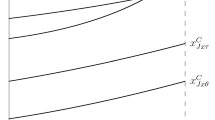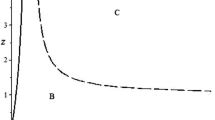Abstract
We investigate the interplay between environmental policy, incentives to adoptnew technology, and repercussions on R&D. We study a model where a monopolistic upstream firm engages in R&D and sells advanced abatement technology to polluting downstream firms. We consider four different timing and commitment regimes of environmental tax and permit policies: ex post taxation (or issuing permits), interim commitment to a tax rate (a quota of permits) after observing R&D success but before adoption, and finally two types of ex antecommitment before R&D activity, one with a unique tax rate (quota of permits), the other one with a menu of tax rates (permit quotas). We study the second best tax and permit policies and rank these with respect to welfare. In particular, we find that commitment to a menu of tax rate dominates all other policy regimes.
Similar content being viewed by others
References
Arrow, K. (1962), ‘Economic Welfare and the Allocation of Resources for Innovations,’ in R. Nelson, ed., The Rate of Direction of Inventive Activity, Princeton University Press.
G. Biglaiser J. K. Horowitz (1995) ArticleTitle‘Pollution Regulation and Incentives for Pollution-Control Research,’ Journal of Economics and Management Strategy 3 IssueID4 663–684
V. Denicolo (1999) ArticleTitle‘Pollution-Reducing Innovations under Taxes or Permits,’ Oxford Economic Papers 51 184–199 Occurrence Handle10.1093/oep/51.1.184
P. B. Downing L. J. White (1986) ArticleTitle‘Innovation in Pollution Control,’ Journal of Environmental Economics and Management 13 18–29 Occurrence Handle10.1016/0095-0696(86)90014-8
C. Fisher I. Parry W. Pizer (2003) ArticleTitle‘Instrument Choice for Environmental Protection When Technological Innovation is Endogenous,’ Journal of Environmental Economics and Management 45 523–545 Occurrence Handle10.1016/S0095-0696(03)00002-0
Jaffe, A., G. Newell, and R. Stavins (2000), ‘Technological Change and the Environment,’ NBER Working Paper 7970, October.
Ch. Jung K. Krutilla R. Boyd (1996) ArticleTitle‘Incentives for Advanced Pollution Abatement Technology at the Industry Level: An Evaluation of Policy Alternatives’ Journal of Environmental Economics and Management 30 95–111 Occurrence Handle10.1006/jeem.1996.0007
Kneese, A.V. and C.L. Schulze (1975), Pollution, Prices and Public Policy, Washington, DC, Brookings
J. O. Lanjouw A. Mody (1995) ArticleTitle‘Innovation and The International Diffusion of Environmental Responsive Technology’ Research Policy 25 549–571 Occurrence Handle10.1016/0048-7333(95)00853-5
S. R. Milliman R. Prince (1989) ArticleTitle‘Firm Incentives to Promote Technological Change in Pollution Control,’ Journal of Environmental Economics and Management 17 247–265 Occurrence Handle10.1016/0095-0696(89)90019-3
I. Parry (1995) ArticleTitle‘Optimal Pollution Taxes and Endogenous Technological Progress,’ Resource and Energy Economics 17 69–85 Occurrence Handle10.1016/0928-7655(94)00010-H
E. Petrakis A. Xepapadeas (1999) ‘ To Commit or not to Commit: Environmental Policy in Imperfect Markets,’ University of Crete Mimeo
T. Requate (1995) ArticleTitle‘Incentives to Adopt New Technologies Under Different Pollution-Control Policies,’ International Tax and Public Finance 2 295–317 Occurrence Handle10.1007/BF00877503
T. Requate W. Unold (2001) ArticleTitle‘On the Incentives of Policy Instruments to Adopt Advanced Abatement Technology if Firms are Asymmetric’, Journal of Institutional and Theoretical Economics 157 536–554 Occurrence Handle10.1628/0932456012974468
T. Requate W. Unold (2003) ArticleTitle‘On the Incentives of Environmental Policy to Adopt Advanced Abatement Technology – Will the True Ranking Please Stand up?’ European Economic Review 47 125–146 Occurrence Handle10.1016/S0014-2921(02)00188-5
M. Weitzman (1974) ArticleTitle‘Prices vs Quantities,’ Review of Economic Studies 41 477–491 Occurrence Handle10.2307/2296698
J. Zhao (2003) ArticleTitle‘Irreversible Abatement Investment under Cost Uncertainties,’ Journal of Public Economics 87 2765–2789 Occurrence Handle10.1016/S0047-2727(02)00135-4
Author information
Authors and Affiliations
Corresponding author
Rights and permissions
About this article
Cite this article
Requate, T. Timing and Commitment of Environmental Policy, Adoption of New Technology, and Repercussions on R&D. Environ Resource Econ 31, 175–199 (2005). https://doi.org/10.1007/s10640-005-1770-x
Accepted:
Issue Date:
DOI: https://doi.org/10.1007/s10640-005-1770-x




